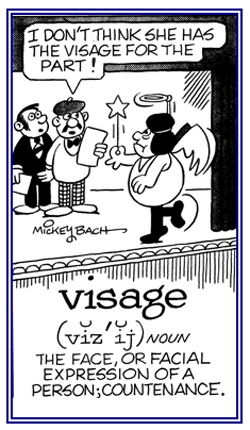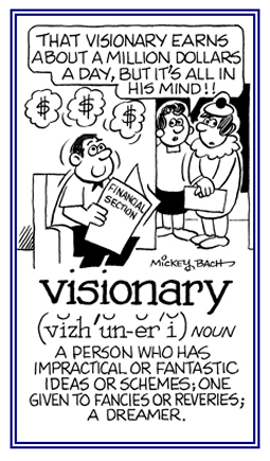vid-, video-, vis-, -vision, -visional, -visionally, visuo-, vu-
(Latin: videre, "to see"; plus words with other related meanings: to notice, noticing, noticed; observe, observing, observed; look, looking, looked; perceive, perceiving, perceived, perception; see, seeing, saw, seen, sight; view, viewing, viewed; manifest, manifesting, manifested; reveal, revealing, revealed, revelelation)
Although many of the words in this unit seem to be from other Latin origins, all of them are etymologically derived from the main Latin videre, "to see" element.
2. An endorsement made in a passport which allows the bearer to enter the country issuing it.
3. Etymology: "official signature or endorsement on a passport", from French visa, from Modern Latin charta visa, "verified paper"; literally, "paper that has been seen"; from Latin videre, "to see".
2. Etymology: from Old French visage, from vis, "face, appearance"; from Latin visus. "a look, a vision"; from the stem of videre, "to see".

Go to this Word A Day Revisited Index
so you can see more of Mickey Bach's cartoons.
2. Someone who has the same functions and characteristics as another; a counterpart.
3. Etymology: from French "face to face"; from Old French vis, "face"; from Latin visus, "faculty of seeing, sight, vision"; past participle of videre, "to see".
2. A tool with two jaws that can be closed with a lever or screw, used to hold an object immobile so a someone can work on it.
3. Etymology: "a device like a screw or winch for bending a crossbow or catapult", from Old French vis, viz, "screw"; from Latin vitis, "vine, tendril of a vine"; literally, "that which winds"; from the base of viere, "to bind, to twist".
2. The relative ability to be seen under given conditions of distance, light, atmosphere, etc.: "The visibility was low because of the fog."
3. The extent to which it is possible to anticipate a future trend or situation; the "distance" that it is possible to "see" into the future.
4. The quality, fact, or degree of being visible which is perceptible with the eyes or obvious with the eyes.
5. As a measure of weather conditions, the greatest distance in a given direction at which a standard object can be seen and identified with the unaided eyes.
6. Etymology: "the condition of being seen", from Late Latin visibilitas; from Latin visibilis, "that which may be seen"; from visus, past participle of videre, "to see".
2. An instrument; such as, a transmissometer (device used to measure the transmission of light through a medium), for making direct measurements of a visual range in the atmosphere or of the physical characteristics of the atmosphere which determine the visual range.
3. A photometric device for determining the range of visibility during daylight hours.
The measurement is made visually and the visibility meter is also used in lighting engineering for measuring the values of light (brightness) contrasts between an object and the background against which it is found or projected.
At meteorological stations visibility meters are used to measure the transparency of the atmosphere in a horizontal direction by measuring the contrast of a remote dark object; for example, a forest, against the background of the sky. There will be less contrast as the air transparency decreases.
2. Frequently seen in the public; noticeable, conspicuous.
3. On hand; available: "We have a visible supply of books for our research."
4. Constructed or designed to keep information or an item in view or able to be readily brought to sight.
5. Represented visually, as with symbols.
6. Etymology: from Old French visible, from Latin visibilis, "that which may be seen"; from visus, past participle of videre, "to see".
In the teacher's advanced physics program, his students studied the visible absorptions spectrophotometries of light energy.
"His mother was visibly moved when he was convicted of the crime."
2. The act or power of anticipating that which will or may come to be: Sharon's prophetic visions of what would happen with Ken's investments in his business encouraged him to proceed with his ideas.
3. An experience in which a person, thing, or event appears vividly or credibly to the mind: Although Ben's vision of the future was not actually present, he was still convinced that he had to commit himself to strive for those goals.
4. A vivid, imaginative conception or anticipation: Mary's husband had visions of wealth and glory all of which were only in his mind and not actual.
The following cartoon about visionary illustrates the contents of this vision entry.



